
“The Baker’s percentage expresses each ingredient in parts per hundred as a ratio of the ingredient’s mass to the total flour mass”
Bekijk hier de Nederlandse versie
You may ask yourself: As a home baker, do I really need this baker’s percentage stuff to make a good loaf of bread? The answer is no, you don’t. But, if you are fond of numbers and want to know what others are talking about do read on!
In a recipe based on baker’s percentage all ingredients are calculated in relation to the total amount of flour within the recipe. This means, to start with we always denominate the total amount of flour as 100%. This total amount includes all the flour used in a recipe so must also include different types of flour and the flour in a preferment if this is part of the recipe.
HELPFUL EXAMPLES
With this example you can perform a lot of helpful calculations, quickly calculating the right amounts for all ingredients. A typical straightforward recipe may look like this:
| Ingredient | Percentage |
|---|---|
| flour | 100% |
| water | 63% |
| salt | 1.8% |
| dry yeast | 1.4% |
| butter | 4% |
| total dough | 170.2% |
Example 1 : You want to make 6 loaves of 750 g each
When you want to make 6 loaves of bread weighing 750 g each, you can easily calculate all ingredients. For 6 loaves you need 6 x 750 = 4500 g of dough. The first step is to calculate the amount which represent 1%. For this example recipe the total combined percentage figure for 4500 g is 170.2% (see above in table: all the percentages of all ingredients added up).
Now to get to 1% you need to divide 4500 by 170.2 = 26.44 g. So each 1% represents 26.44 g, and by multiplying all percentages by 26.44 g we get the following recipe;
| Ingredient | Percentage | Total |
|---|---|---|
| flour | 100% x 26.44 | 2644 g |
| water | 63% x 26.44 | 1666 g |
| salt | 1.8% x 26.44 | 48 g |
| dry yeast | 1.4% x 26.44 | 37 g |
| butter | 4% x 26.44 | 106 g |
| total dough | 170.2% x 26.44 | 4500 g |
Example 2 : Now you want to make 12 loaves of 250 g each
As with our first example we need to calculate the weight of the total dough, which is 12 x 250 g = 3000 g. With this we can again calculate 1% = 3000 / 170.2% = 17.62 g. This gives us the following recipe with a total dough batch of 2999 g which is close enough of course :
| Ingredient | Percentage | Total |
|---|---|---|
| flour | 100% x 17.62 | 1762 g |
| water | 63% x 17.62 | 1110 g |
| salt | 1.8% x 17.62 | 32 g |
| dry yeast | 1.4% x 17.62 | 25 g |
| butter | 4% x 17.62 | 70 g |
| total dough | 170.2% x 17.62 | 2999 g |
Example 3 ; You want to bake 4 loaves of 500 g
You have found a nice recipe in a bread book. However instead of using the amounts given in the recipe, you want to make 4 loaves of 500 g each.
Recipe from book you want to use
| Ingredient | Amount |
|---|---|
| wholewheat flour | 50 g |
| flour | 400 g |
| water | 298 g |
| salt | 8 g |
| dry yeast | 6 g |
First of all you need to calculate the the total amount of flour (50 + 400 = 450 g). With this number you can now calculate all the bakers percentages of the recipe. First take 1% of the total amount of flour which is 450 ÷ 100 = 4.5 g. Now you need to divide all the amounts of the recipe by 4.5 to calculate the baker’s percentages.
Recipe turned into baker’s percentages
| Ingredient | Amount | Percentage |
|---|---|---|
| wholewheat flour | 50 g | 50 ÷ 4.5 = 11% |
| flour | 400 g | 400 ÷ 4.5 = 89% |
| water | 298 g | 298 ÷ 4.5 = 66% |
| salt | 6 g | 8 ÷ 4.5 = 1.77% |
| dry yeast | 6 g | 6 ÷ 4.5 = 1.33% |
| total | 169.1% |
With this table you scale the recipe to bake 4 loaves like we did in example 1 and 2. The total amount of dough needed is 4 * 500 g = 2000 g. The total percentage of this recipe is 169.1%, now take 1% = 2000 / 169.1 = 11.82 g.
| Ingredient | Percentage | Amount |
|---|---|---|
| wholewheat flour | 11% x 11.82 g | 130 g |
| flour | 89% x 11.82 g | 1051 g |
| water | 66% x 11.82 g | 780 g |
| salt | 1.77% x 11.82 g | 21 g |
| dry yeast | 1.33% x 11.82 g | 16 g |
| total | 169.1% x 11.82 g | 1998 g |
Using the WKB dough calculator
To a lot of recipes on our website we added our WKB dough calculator. With this calculator you can scale our recipes with just a few simple clicks. The WKB dough calculator also uses baking percentages behind the scenes to do the calculations. Give the calculator a try by first clicking on ‘Open WKB Dough Calculator’. Now you can change amounts, change the hydration of the dough, number of batches, the amount of flour etc. The calculator will help you to scale the basic recipe. Click on the button below and give it a try.
| Ingredients for a bread | |||
|---|---|---|---|
| makes 1 loaves | |||
| 500 | g | wheat (bread) flour | |
| 315 | g | water | |
| 9 | g | (sea) salt | |
| 7 | g | instant yeast | |
| 20 | g | butter | |
Check out some of our favorite bread recipes with added dough calculator:
– Pain Rustique – a hybrid version with sourdough preferment
– 80% hydration baguettes
– Baguette boules – a fun and delicious take on a baguette recipe yielding wonderful sandwiches
– Semolina and sesame loaf – a yeast based bread that can easily be adapted to give it your own twist
– Our version of a Tartine style loaf – probably the best tasting sourdough bread we ever made




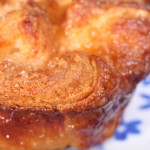
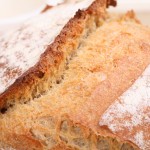
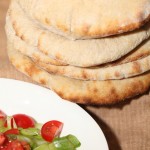
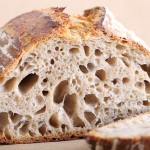
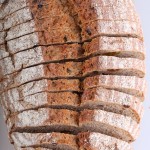
Grampa says
I make bread. not that well, but i have been making it for years and have recently gone to weighing the water and flour for a 3:5 ratio. This morning ( i am making pizza for the game sunday ) i wanted 2/7ths of the risen dough for the pizza. i weighed 48 ounces of flour and 18 ounces of water and kneaded it and let it rise. When i went to split the first rise the entire dough weighed 50 ounces. How is that possible? (there is nothing wrong with my scale but i am realy old)
Weekend Bakers says
Hello Grampa,
Are you sure you did not weigh 30 ounces of flour. Because that would match with the 18 ounces of water and your 3:5 ratio. When adding up 18 plus 30 and a bit of yeast and salt…50 ounces!
Hope this is the answer to your question. No matter what age, we all make mistakes when baking 🙂
Brodie says
To clarify: the formula extends beyond just bread and works for cakes and pastry as well. But a recipe may call for a certain amount of frosting or a particular amount of a pastry cream.
I have found conversion tables and started to understand the formula enough to start converting all of my recipes into formulas but it would be nice to be able to do that with recipes that don’t contain flour as well
BRODIE says
What happens to the formula if there is no flour involved? eg. Frosting or custards
Suzanne says
Why not help all of us novice bread makers and get an app?
I appreciate your column, but worry it will all be lost one day! Many thanks Suzanne
Nir says
Per your request – a link to a baker’s percentage calculator 🙂
appia.co.il/calcu…uage=en-us
Suzanne says
I bought 500 gm of diagnostic malt flour, with the aim to make a malt loaf! I’ve found I got it totally wrong! I use a 200lb bread machine, and don’t know how much of the malt powder to add, and whether I have to decrease the flour, or increase the water? and what about yeast? Do I do anything to that?
I enjoyed your price on bread making, it’s only since the pandemic I’ve taken up making my own bread, but it seems like an everlasting journey of learning! Dose it get easier? Would appreciate your opinion!
Many thanks Suzanne Hunt
sjh-suzanne@hotmail.co.uk
UK 07484815486
Harry Posthumus says
I do not see any amount of sugar /Shortening in your recipes
Weekend Bakers says
Hello Harry,
If you look at other recipes like this one:
www.weekendbakery.com/posts…-favorite/
you will see all kinds of other ingredients like sugar, honey, oil, butter, egg and so on.
Joanna says
Hi, may i know how about the egg? Do you calculate in it or is it just an additional and will not affect anything? And if i want to increase the total hydration of the original recipe, should i adjust the total of flour, and butter and yeast too? If yes, may i know how to calculate it? Thank you.
Weekend Bakers says
Yes, egg is part of the calculation as you can also see in this recipe for example:
www.weekendbakery.com/posts…d-version/
Egg contains water (the egg white is about 90% water) and fat (the yolk) so you can also look at it as adding extra liquid and fat to your mixture.
Increasing hydration is mainly done by adding more liquid. You can easily do this in our dough calculator you see with the above recipe for example. You open the calculator and change the water % and see how much water you need to add and what the total hydration for the recipe is.
lawson baron says
The weight of flour varies depending on the recipe book. My old Fleishmann’s
Book weighs flour at 150 gm/cup. Other books have no comparison ( much older books, before Canada adopted metric system.) The baker’s formula will be very useful to me in future.
Lawson.
Weekend Bakers says
Thank you Lawson, we are happy we grew up baking with the metric system and scales, it makes consistency in baking so much easier.
Rajh says
I get really impressed
Jerry says
Thank you for doing that for me.
I think I have it know. Is the yeast dry or using a stater yeast?
This way now if I want to use less water that’s all I have to do is then used a calculator.
Weekend Bakers says
Instant yeast is a dry yeast Jerry.
Lilian says
Thank you for the information really learnt a lot. My question is how do I know the percentage amount of recipe if I am adding a nut , coconut e.t.c
Weekend Bakers says
Hello Lilian,
When looking at bakers percentage you look mainly at the ratio of flour, water and salt (butter and yeast). These need to balance and need to be worked out for the dough to work. The other ingredients that you mention, are added extra’s and not a substitute for part of the flour for example. So you can calculate what percentage they are compared to the amount of flour, but in general it will not have impact on the actual dough. For example, when you make raisin buns, you can put in 100, 200 or 400 grams of raisins but the actual amount of flour, water and salt used, stays the same, you will just have a more or less filled raisin bun.
Nancy Wong says
Ik wil graag volkoren spelt zuurdesem brood bakken, hoe is de verhouding tussen desemstarter en meel. Moet er altijd bloem erbij? Ivm zwangerschapsdiabetes moet ik zoveel mogelijk volkoren eten.
Weekend Bakers says
Hallo Nancy,
Heb je een recept voor ogen? Onze ideale verhouding is ongeveer 25% voordeeg op het totaal, maar nooit meer dan 50% is het advies. Wij gebruiken altijd een combinatie van tarwebloem en meel, omdat het maken van een 100% volkorenbrood een hele uitdaging is, vooral met 100% spelt. Dat heeft te maken met de vezels en de (soort) gluten. Het ligt er ook aan wat je doel is en wat je lekker vindt. Een echt 100% volkoren(spelt)brood zal een zwaarder, compact brood opleveren, maar gesneden in dunne plakjes kan dat ook gewoon lekker zijn om te eten.
Kijk eens naar ons recept en onze methode:
www.weekendbakery.com/posts…esembrood/
Misschien kun je het als basis gebruiken.
Succes ermee en veel geluk!
Leslie Aguilera says
How would I find the ingredients weight in grams when they provide yield amount and total percentage
Weekend Bakers says
Do you have the amounts for us that you are referring to?
Erin says
What’s the best way to convert American recipes in cups/teaspoons to metric if the recipe doesn’t have them?
Weekend Bakers says
Hello Erin,
We have a very handy page with baking conversion tools for you:
www.weekendbakery.com/cooki…nversions/
Simply choose an ingredient from the list, like all purpose flour, and put in the number of cups and you immediately see that one cup is 125 grams for instance. And vise versa of course.
We also have a multi converter that quickly converts celsius to fahrenheit and instant yeast to fresh et cetera.
Plus under this you will find a table/list to look up all kinds of much used conversions.
Let us know if you are stuck with any ingredient.
Hope this helps!
Magda says
Hi there, I love your website. I’ve learnt a lot from you, and so far I followed your recipes scrupulously and with great results!!! Thank you for all that. Now the time has come to try things on my own :O. And here is my question – if you use baker’s percentage with sourdough bread, do you add to the amount of water the water from the starter, and to the amount of flour the flour from the starter?
Thanks, Magda
Weekend Bakers says
Hello Magda,
Thank you for the love 🙂
And the answer is yes, officially the water and flour from your added starter are also taken into account, most starters are 100% hydration so halve of the weight goes with the flour and halve with the water. But the most important thing to take into account is to see and feel how your dough behaves, because every flour and its absorption is a bit different. So a recipe and percentages are a good starting point but nearly always adjustments need to be made when it comes to the added liquid. Looking at our own recipes, we only add a very small amount of culture to each loaf and only halve of this is water, so a very small amount looking at the total amount of water added. With each batch of flour and each batch we bake we also very much look at the dough and feel it when adding water and based on experience know when to stop adding.
Hope it makes sense 🙂
Greetings,
Marieke & Ed
Yuva says
Hello,
Very useful information! Learned a lot. But when I tried this recipe, the outer crust in my bread is very hard and crusty. Is there any tip to achieve softer crust ?
Thanks, Yuva
Weekend Bakers says
Hello Yuva,
Yes, a lot of recipes make for a crusty bread and that is their intention. If you want a soft loaf you can achieve this among other things by using steam during the whole baking process, baking the bread on a slightly lower temperature, tempering the oven sooner and putting the bread in a bag while it is still a little bit warm. But if your aim is making a bread with a soft and thin crust you can also try making a loaf with the dough from this recipe: www.weekendbakery.com/posts…atic-malt/
A longer fermentation, like with sourdough, will always result in a thicker crust. So choose the recipe based on what you want to achieve too.
Good luck with it.
Albert Willems says
After hours of searching I have not been able to find a site, where the amount of flour indicates the final dough weight and the size of bread tin that is needed. The size of a bread tin can easily be found by filling it with water and see how many ML of water it holds, which is the volume in grams. A sheet of kitchen wrap inside the tin will stop the tin from leaking, while filling it with water. Seven decades ago my father, a professional European baker, already used percentages, but I never asked him, how the dough weight and the bread tin sizes were related.
Weekend Bakers says
Hello Albert,
Thank you for adding your comment and sharing your method and information. The size of tin needed also depends on the type of loaf and its volume of course. For example a whole wheat loaf will be much more compact than a fluffy white milk bread, though both would have the same amount of flour. Bakers would know when making a white loaf of say the standard 800 grams weight after baking, what tin with what volume to use to get the right shape and height. So for instance a whole wheat loaf would need a 28 cm tin and a white loaf a 32 cm tin.
venus gargavite says
thanks for the info..
S. Pingel pingel says
Excellent tool
Weekend Bakers says
Thank you mr. Pingel 🙂
Kati says
Best explanation ever. Easy to follow and understand. Thank you for this.
Weekend Bakers says
Thank you Kati!
Gabriela says
Wonderful tool ! THANK you. Merry Christmas.
Weekend Bakers says
Thank you Gabriela and Merry Christmas too!
omer seyfi salur says
I adored these examples and also learned a lot thank you very much
Weekend Bakers says
Glad you found it useful mr. Salur!
Paul says
Sorry to bother, but how do you calculate the percentage using a starter?
Paul says
Never mind, I think I figured it out. I was trying to triple the “Sourdough mini boules” recipe, and you don’t have your handy calculator on that recipe. but I went to one of your others and saw how it was done. You just use the flour and water content from the starter as % in the recipe, correct? Anyway, I LOVE your site and thank you for helping all of us beginners out here! Cheers!
Weekend Bakers says
Hello Paul,
Yes, that is correct. Although if you only want to make more of a given recipe you do not have to recalculate but just multiply the ingredients (by 3 in your case) and that is it!
Happy boules baking and thank you for the LOVE!
Marieke
luiz domaszak says
Good morning.
Wonderful site with lot of information so useful, recipes, tips thanks everybody.
Best regards.
Weekend Bakers says
Thank you Luiz for your kind comment.
happy baking!
Ed & Marieke
Barry Walker says
Thanks for sharing.
Weekend Bakers says
Happy to!
Joy Roxborough says
Hello Ed and Marieke,
Thanks for this useful post about Bakers percentages. I’m a bit confused though. You see that example where . . . LOL. No worries, I just answered my own question. Let me cut a long story short and just say thanks for a great post. I make your pain naturel almost every week. Sometimes I make it in te evening and say I will have it for breakfast but I often end up eating the lot before bed!
Weekend Bakers says
Hi Joy,
We’re impressed! And thank you for your kind words.
Happy baking and eating,
Ed & Marieke